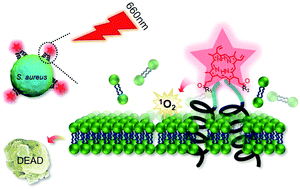A versatile bacterial membrane-binding chimeric peptide with enhanced photodynamic antimicrobial activity†
Abstract
Photodynamic therapy (PDT) has become an effective antibiosis method for overcoming antibiotic resistance. In this study, we developed a versatile bacterial membrane-binding chimeric peptide PpIX-[PEG8-(KLAKLAK)2]2 (denoted as PPK) by conjugating a photosensitizer protoporphyrin IX (PpIX) with an antimicrobial peptide (KLAKLAK)2 (KLA) for effective photodynamic inactivation of bacteria. The chimeric peptide PPK with positively charged properties and an α-helical conformation could rapidly bind to microbial cells through electrostatic interactions and membrane insertion. Moreover, PPK could disrupt the bacterial membrane and further elicit lipid bilayer leakage to kill bacteria by toxic reactive oxygen species (ROS) generated by PpIX under 660 nm light. In vitro experiments demonstrated that cationic PPK possessed excellent antimicrobial activity against both Gram-positive bacteria Staphylococcus aureus (S. aureus) and Gram-negative bacteria Escherichia coli (E. coli). Afterward, PPK also exhibited perfect therapeutic effects on S. aureus-infected mice without any systemic side effects. This chimeric peptide PPK will show great potential for photodynamic antibiosis.



 Please wait while we load your content...
Please wait while we load your content...